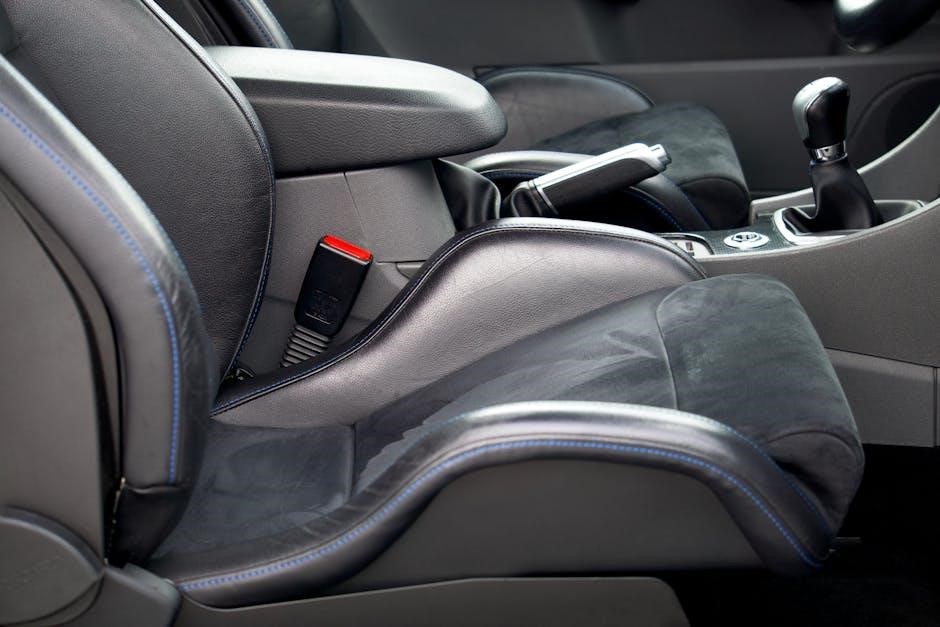The “See Manual” message on a Ford Fusion indicates a detected issue, often related to powertrain or high voltage systems, prompting drivers to consult the owner’s manual for guidance or troubleshooting steps; This alert is designed to notify the driver of a potential problem that requires attention. When this message appears, it suggests that the car’s onboard computer has identified a fault code, which is typically stored in the system. The message prompts the driver to consult the owner’s manual for further guidance or instructions. In some cases, it may also illuminate a wrench light on the dashboard, signaling that the vehicle should be serviced or repaired. Understanding this message is crucial for maintaining the vehicle’s health and ensuring safe operation.
Overview of the Ford Fusion
The Ford Fusion is a popular midsize sedan produced by Ford from 2006 to 2020. Known for its reliability and advanced features, the Fusion offers a blend of comfort, performance, and technology. It is available in various models, including hybrid versions, catering to diverse driver preferences. The Fusion features modern systems that monitor vehicle health, making it essential for owners to understand dashboard messages like “See Manual.” This message often indicates issues related to powertrain or high voltage systems, guiding drivers to consult the owner’s manual for troubleshooting and maintenance. Understanding these alerts is crucial for maintaining the vehicle’s performance and longevity.
The Importance of Understanding Dashboard Messages
Understanding dashboard messages in your Ford Fusion is vital for maintaining vehicle health and ensuring safety on the road. These messages, such as “See Manual,” serve as critical alerts that indicate potential issues requiring attention. Ignoring them can lead to more severe mechanical failures, increased repair costs, and even safety hazards. By familiarizing yourself with the meaning of these alerts, you can take prompt action, whether it involves troubleshooting, consulting the owner’s manual, or seeking professional assistance. Regular awareness of dashboard indicators helps prevent minor issues from escalating, ensuring optimal performance and longevity of your vehicle. Stay informed to drive confidently and avoid unnecessary complications down the road.
What Does “See Manual” Mean on Ford Fusion?
The “See Manual” message on a Ford Fusion indicates a detected issue, often related to powertrain or high voltage systems, prompting drivers to consult the owner’s manual for guidance or troubleshooting steps. This alert is designed to notify the driver of a potential problem that requires attention. When this message appears, it suggests that the car’s onboard computer has identified a fault code, which is typically stored in the system. The message prompts the driver to consult the owner’s manual for further guidance or instructions. In some cases, it may also illuminate a wrench light on the dashboard, signaling that the vehicle should be serviced or repaired. Understanding this message is crucial for maintaining the vehicle’s health and ensuring safe operation.
Explanation of the “See Manual” Message
The “See Manual” message on a Ford Fusion signals that the vehicle has detected a specific issue, often related to its powertrain or high voltage system. This alert is triggered when the car’s onboard computer identifies a fault code, which is then stored in the system. The message prompts the driver to consult the owner’s manual for further guidance or troubleshooting steps. In some cases, it may also illuminate a wrench light on the dashboard, signaling that the vehicle should be serviced or repaired. Understanding this message is crucial for maintaining the vehicle’s health and ensuring safe operation. Ignoring it can lead to further complications, so it is essential to address the issue promptly.
The Wrench Icon and Its Significance
The wrench icon on a Ford Fusion is a visual indicator that accompanies the “See Manual” message, signaling a potential issue with the vehicle’s systems. This icon is often linked to powertrain-related problems, such as engine or transmission faults, and may also appear in hybrid models due to high voltage system malfunctions. When the wrench light illuminates, it serves as a warning for the driver to take action. The icon is designed to alert the driver of a detected issue that requires attention, prompting them to consult the owner’s manual for guidance or to seek professional assistance. Ignoring this warning can lead to more severe complications, making it essential to address the issue promptly to ensure the vehicle’s optimal performance and safety on the road.

Why Does the “See Manual” Message Appear?
The “See Manual” message appears due to issues like powertrain faults, transmission problems, or high voltage system malfunctions, prompting drivers to seek guidance in the owner’s manual or from professionals.
Powertrain Issues
Powertrain issues are a common cause of the “See Manual” message in Ford Fusion vehicles. These issues can range from engine faults to transmission problems, often triggered by sensor malfunctions or mechanical failures. The powertrain control module detects irregularities and stores fault codes, which may result in the message appearing. Drivers may experience symptoms like erratic shifting, loss of power, or the vehicle entering limp mode to prevent further damage. Ignoring these warnings can lead to more severe damage or costly repairs. Using an OBD-II scanner to retrieve fault codes, such as P0700 for transmission issues or P0300 series for engine misfires, helps identify the root cause. Addressing powertrain issues promptly is essential to maintain vehicle performance and reliability, ensuring safe and efficient operation. Regular maintenance and professional diagnostics are recommended to resolve these problems effectively.
Transmission Faults
Transmission faults are a common trigger for the “See Manual” message in Ford Fusion vehicles. These issues often stem from problems within the transmission control module or mechanical components like clutch packs or gear sensors. Symptoms may include erratic shifting, slipping gears, or hesitation when accelerating. In severe cases, the vehicle may enter limp mode to prevent further damage. Fault codes such as P0700 or P0750 may be stored, indicating specific transmission-related issues. Ignoring these warnings can lead to costly repairs, such as replacing the entire transmission. Addressing transmission faults promptly is crucial to avoid escalating damage and ensure smooth vehicle operation. Professional diagnostics are often necessary to resolve these issues effectively.
High Voltage System Malfunctions in Hybrid Models
In Ford Fusion hybrid models, the “See Manual” message can indicate malfunctions within the high voltage system. This system, integral to hybrid functionality, may experience faults in the battery, electric motor, or power electronics. Such issues can trigger warning lights and store specific fault codes, such as P1A0C, which relates to hybrid battery performance. Ignoring these warnings can lead to reduced fuel efficiency, decreased performance, or even complete system failure. The vehicle may enter a limp mode to protect itself, limiting functionality until repairs are made. Addressing these issues promptly is essential to maintain hybrid efficiency and prevent long-term complications. Professional diagnostics are often required to resolve these complex electrical faults effectively. Regular maintenance can help mitigate these risks and ensure optimal hybrid system function.

Dashboard Warning Lights and Their Meanings
In Ford Fusion, dashboard warning lights like the wrench icon, check engine light, or transmission warning light indicate specific issues, guiding drivers to consult the manual for diagnostics and repairs. These lights signal powertrain faults, transmission problems, or high voltage system malfunctions, prompting immediate attention to ensure vehicle safety and performance. Understanding these lights is crucial for addressing issues before they escalate, ensuring timely repairs and maintaining optimal vehicle function. Each light corresponds to specific systems, providing drivers with vital information about potential problems. Ignoring these warnings can lead to more severe damage or safety risks. The combination of warning lights and the See Manual message emphasizes the importance of addressing the issue promptly. Consulting the owners manual or using an OBD-II scanner can help identify the fault codes, guiding drivers toward the necessary repairs or maintenance. Understanding these warning systems is essential for maintaining vehicle health and ensuring driver safety on the road.
Common Warning Lights Associated with “See Manual”
The “See Manual” message on a Ford Fusion is often accompanied by specific dashboard warning lights, such as the wrench icon, check engine light, or transmission warning light. These lights indicate issues like powertrain faults, engine problems, or transmission malfunctions. The wrench light typically signals a powertrain-related issue, while the check engine light may point to problems with sensors, fuel systems, or emissions. The transmission warning light indicates potential gearbox faults or fluid level issues. In hybrid models, high voltage system lights may also illuminate, signaling issues with the hybrid battery or electric motor. These lights guide drivers to consult the manual for troubleshooting steps or professional assistance, ensuring timely resolution to maintain vehicle performance and safety.
Check Engine Light and Its Implications
The check engine light is a common warning that often accompanies the “See Manual” message in Ford Fusion vehicles. This light illuminates when the car’s onboard computer detects issues such as a loose gas cap, faulty oxygen sensor, or more severe engine problems like misfires or coolant temperature sensor malfunctions. The light may flash or remain steady, indicating the severity of the issue. Ignoring the check engine light can lead to decreased performance, reduced fuel efficiency, and potentially costly damage. When paired with the “See Manual” message, it signals the need to consult the owner’s manual or use an OBD-II scanner to retrieve fault codes for precise diagnosis and necessary repairs.
Transmission Warning Light
The transmission warning light in a Ford Fusion illuminates when the vehicle detects issues with the transmission system. This could indicate problems such as faulty sensors, low transmission fluid levels, or malfunctioning solenoids. When this light appears alongside the “See Manual” message, it suggests that the transmission control module has identified a fault, potentially affecting gear shifting or overall transmission performance. Drivers may notice symptoms like slipping gears, erratic shifting, or difficulty engaging gears. Ignoring this warning can lead to further damage, such as costly repairs or even transmission failure. Consulting the owner’s manual or using an OBD-II scanner can help identify specific fault codes, guiding necessary repairs to restore proper transmission function.

Diagnosing the “See Manual” Message
Diagnosing the “See Manual” message involves using an OBD-II scanner to retrieve fault codes, which help identify specific issues like powertrain or transmission faults.
Common causes include the wrench icon, signaling drivetrain problems, or high voltage system malfunctions in hybrid models, requiring prompt attention to avoid further complications.
Using an OBD-II Scanner
An OBD-II scanner is a crucial tool for diagnosing the “See Manual” message in your Ford Fusion. It connects to the vehicle’s onboard computer via the OBD-II port, typically located under the dashboard. Once connected, the scanner retrieves specific fault codes stored in the system, providing detailed insights into the issue. These codes help identify whether the problem lies in the engine, transmission, high voltage system, or other components. For example, a P0700 code might indicate a transmission control system malfunction, while a P1A0C could point to a hybrid battery issue in Fusion Hybrid models. This step is essential for pinpointing the root cause of the “See Manual” message and guiding the appropriate repair actions.
Retrieving Fault Codes
Retrieving fault codes is a critical step in diagnosing the “See Manual” message on your Ford Fusion. Using an OBD-II scanner, you can access the vehicles onboard diagnostics system to retrieve specific codes stored when the message appears. These codes, such as P0700 for transmission issues or P1A0C for hybrid battery faults, provide detailed insights into the problem. Once retrieved, these codes can be cross-referenced in the owner’s manual or a repair manual to understand their meaning. This process allows you to identify whether the issue lies in the powertrain, transmission, or high voltage system, enabling targeted repairs. Accurate code retrieval is essential for resolving the “See Manual” message effectively and ensuring the vehicle operates safely and efficiently.
Interpreting Fault Codes for Specific Issues
Interpreting fault codes is essential for addressing the “See Manual” message on your Ford Fusion. Once retrieved using an OBD-II scanner, these codes help pinpoint specific issues. For example, a P0700 code indicates a transmission control system malfunction, while a P1A0C code points to a hybrid battery fault in Fusion Hybrid models. Generic codes (P0xxx) and manufacturer-specific codes (P1xxx, P2xxx) provide detailed insights into engine, transmission, or high voltage system malfunctions. By cross-referencing these codes in the owner’s manual or a repair guide, you can identify the root cause of the problem. This step is crucial for determining whether the issue requires DIY fixes or professional intervention, ensuring timely and effective repairs to restore your vehicle’s performance and safety.

Checking for Additional Warning Lights
When the “See Manual” message appears, check for additional warning lights like the wrench icon, check engine, or transmission lights to identify specific issues and prevent complications.
Identifying Accompanying Dashboard Lights
When the “See Manual” message appears, it is often accompanied by specific dashboard warning lights that provide additional context. These lights, such as the wrench icon, check engine light, or transmission warning light, help pinpoint the issue. The wrench light typically indicates a powertrain-related problem, while the check engine light may signal engine or emissions system faults. Transmission warning lights suggest issues with gear shifting or fluid levels. Identifying these lights is crucial for understanding the nature of the problem and taking appropriate action. By recognizing the combination of lights and messages, drivers can better diagnose the issue and address it effectively to prevent further complications. This step is essential for resolving the “See Manual” message and ensuring the vehicle operates safely and efficiently.
Understanding the Combination of Lights and Messages
The combination of the “See Manual” message and specific dashboard lights provides crucial insights into the nature of the issue. For instance, the wrench icon often accompanies powertrain-related problems, signaling the need for immediate attention. Meanwhile, the check engine light may indicate issues with the engine or emissions system. Transmission warning lights suggest problems with gear shifting or fluid levels. By understanding the relationship between these lights and messages, drivers can better diagnose the problem. This combination helps identify whether the issue is minor, like a loose gas cap, or more severe, such as a transmission fault. Addressing these issues promptly is essential to prevent further damage and ensure the vehicle’s optimal performance.

Visiting a Ford Service Center
Visiting a Ford Service Center ensures professional diagnosis and repair by certified technicians, equipped with advanced tools to accurately address “See Manual” issues, restoring performance and preventing future complications.
Importance of Professional Diagnosis
Professional diagnosis by Ford-certified technicians is crucial for accurately identifying and resolving issues indicated by the “See Manual” message. Their expertise ensures precise fault identification using advanced tools and diagnostic equipment. Technicians can access detailed codes and perform comprehensive checks to determine the root cause, whether it’s a powertrain malfunction, transmission fault, or high voltage system issue. They also apply the latest technical updates and factory guidelines, ensuring repairs are done correctly and safely. Professional diagnosis prevents misdiagnosis and ensures that all related problems are addressed, avoiding further complications. It’s essential for maintaining the vehicle’s performance, reliability, and long-term health.
Benefits of Ford-Certified Technicians
Ford-certified technicians offer unparalleled expertise in diagnosing and resolving issues related to the “See Manual” message. Their specialized training and access to advanced diagnostic tools ensure accurate identification of faults. They are well-versed in interpreting fault codes and applying the latest Ford updates and technical bulletins; Their deep understanding of Ford-specific systems, such as powertrain and high voltage components, enables precise and efficient repairs. By leveraging their knowledge, technicians can address issues promptly, preventing further damage and ensuring optimal vehicle performance. Their work is backed by Ford standards, providing drivers with peace of mind and confidence in the quality of the repairs.
Advanced Diagnostic Tools and Techniques
Advanced diagnostic tools and techniques play a crucial role in addressing the “See Manual” message on Ford Fusion vehicles. Ford-certified service centers utilize state-of-the-art equipment, such as proprietary diagnostic systems, to identify and resolve issues efficiently. These tools enable technicians to access detailed fault codes, perform real-time system analysis, and apply the latest software updates. Techniques such as scanning for fault codes, analyzing live data streams, and running system tests ensure precise identification of problems. Additionally, advanced tools like Ford’s Integrated Diagnostic System (IDS) provide in-depth insights into complex systems, such as the powertrain and high voltage components. These resources ensure accurate diagnoses and effective repairs, preventing further damage and restoring vehicle reliability.

Addressing the Underlying Causes
The “See Manual” message often stems from powertrain issues, transmission faults, or high voltage malfunctions in hybrids. Professional diagnosis is crucial to identify and resolve these issues effectively.
Common Causes of Powertrain Issues
Common causes of powertrain issues in Ford Fusion include faulty sensors, software glitches, or mechanical failures. These can lead to irregular engine performance, transmission problems, or hybrid system malfunctions. Faulty oxygen sensors or coolant temperature sensors may trigger powertrain-related fault codes, while transmission issues like slipping gears or low fluid levels can also activate the “See Manual” message. In hybrid models, high voltage system faults, such as battery or electric motor malfunctions, are additional contributors. Addressing these issues promptly is essential to prevent further damage and ensure optimal vehicle performance. Regular maintenance and inspections can help mitigate these risks.
Resolving Transmission Problems
Transmission problems in the Ford Fusion, often indicated by the “See Manual” message, can stem from faulty sensors, fluid leaks, or worn components. Symptoms like erratic shifting or slipping gears may occur. To address these issues, drivers should first use an OBD-II scanner to retrieve specific fault codes, such as P0700 for transmission control system malfunctions. Checking transmission fluid levels and condition is also crucial, as low or degraded fluid can trigger warnings. In some cases, recalibrating the transmission or replacing faulty solenoids may be necessary. Severe issues, such as clutch pack wear, may require professional repair or replacement. Prompt action is essential to prevent further damage and ensure smooth operation.

Fixing High Voltage System Faults
In Ford Fusion hybrid models, high voltage system faults triggering the “See Manual” message often involve the battery, electric motor, or power electronics. These issues may cause reduced efficiency or system failure. Drivers should use an OBD-II scanner to retrieve fault codes, such as those related to hybrid battery performance or inverter faults. Professional diagnosis is critical, as these systems are complex and require specialized tools. Repairs may involve replacing faulty battery modules, updating software, or addressing electrical connections. Ignoring these issues can lead to system failure or safety risks. Addressing high voltage faults promptly ensures optimal hybrid performance and prevents further complications, requiring expertise from certified technicians.

Preventative Maintenance
Regular maintenance, such as checking fluid levels, inspecting belts, and ensuring proper tire pressure, helps prevent issues that could trigger the “See Manual” message, ensuring optimal performance and longevity.
Regular Maintenance to Avoid “See Manual” Messages
Regular maintenance is key to preventing “See Manual” messages. Schedule routine inspections and follow the recommended maintenance plan in your Ford Fusion’s owner’s manual. This includes checking fluid levels, inspecting belts and hoses, and ensuring proper tire pressure. Addressing minor issues early can prevent them from escalating into major problems. Additionally, keeping track of service history helps identify potential faults before they trigger dashboard warnings. By staying proactive with maintenance, you can reduce the likelihood of encountering the “See Manual” message and ensure your vehicle runs smoothly and efficiently over time. Consistency in upkeep is vital for long-term reliability and performance.
Importance of Routine Checks

Understanding the “See Manual” Message on Your Ford Fusion
What Does “See Manual” Mean?
The “See Manual” message on your Ford Fusion’s dashboard, often accompanied by an orange wrench icon, indicates that the car’s computer has detected an issue. This could be related to the powertrain, which includes the engine, transmission, and drivetrain. While the message is vague, it suggests that you should consult the owner’s manual for guidance on potential problems and solutions.
Common Causes of the “See Manual” Message
The message might appear due to various issues, ranging from minor problems like a loose gas cap or low fluid levels to more serious mechanical faults. It’s important to investigate the cause to determine the severity of the issue.
Steps to Diagnose the Issue
To diagnose the problem, start by consulting the owner’s manual for information on dashboard warning lights. Consider checking for obvious issues like a loose gas cap. For more detailed information, use an OBD-II scanner to retrieve fault codes, which can provide specific insights into the problem. If you’re unsure, visiting a mechanic familiar with Ford vehicles can ensure an accurate diagnosis and appropriate repairs.
Monitoring the Vehicle’s Performance
Keep an eye on the dashboard for additional warning lights, such as the check engine or transmission light, which can offer more clues. Also, observe the car’s performance for symptoms like rough running, hesitation, or difficulty shifting gears. These observations can help narrow down potential causes and guide the next steps in addressing the issue.
The “See Manual” message serves as a prompt to investigate and address potential issues with your Ford Fusion. While it could indicate something minor, it’s crucial to take action to prevent more serious problems from developing. By consulting the manual, checking for obvious issues, and seeking professional help if needed, you can ensure your car remains in good condition and runs smoothly.
Scheduled Servicing and Inspections
Regular servicing and inspections are vital for maintaining your Ford Fusion’s health and preventing issues that may trigger the “See Manual” message. Staying on top of the recommended maintenance schedule, as outlined in the owner’s manual, ensures that potential problems are identified and addressed early. Routine checks, such as oil changes, fluid level inspections, and battery tests, help maintain optimal performance. Additionally, scheduled inspections by a Ford-certified technician can detect hidden issues before they escalate. By adhering to these routines, you can avoid unexpected system malfunctions and reduce the likelihood of encountering the “See Manual” alert. Consistent upkeep is key to a smooth and reliable driving experience.
The “See Manual” message on a Ford Fusion signals a detected issue, often related to powertrain or high voltage systems, prompting drivers to consult the owner’s manual for guidance or troubleshooting steps. This alert is designed to notify the driver of a potential problem that requires attention. When this message appears, it suggests that the car’s onboard computer has identified a fault code, which is typically stored in the system. The message prompts the driver to consult the owner’s manual for further guidance or instructions. In some cases, it may also illuminate a wrench light on the dashboard, signaling that the vehicle should be serviced or repaired. Understanding this message is crucial for maintaining the vehicle’s health and ensuring safe operation.
The “See Manual” message on a Ford Fusion indicates a detected issue, often related to powertrain or high voltage systems. It signals the need to consult the owner’s manual for guidance. This message typically appears alongside dashboard warning lights, such as the wrench icon or check engine light, which point to specific faults. Common causes include engine or transmission problems, sensor malfunctions, or hybrid system faults. Ignoring this message can lead to more severe damage, so prompt action is essential. Drivers should use an OBD-II scanner to retrieve fault codes and address the underlying issues. Regular maintenance and professional diagnostics are key to resolving these problems effectively and ensuring the vehicle’s optimal performance and longevity. Always refer to the owner’s manual for detailed troubleshooting steps and recommendations.
Final Thoughts on the “See Manual” Message
The “See Manual” message on a Ford Fusion serves as a critical alert, reminding drivers to address potential issues promptly. It highlights the importance of understanding dashboard warnings and consulting the owner’s manual for guidance. Ignoring this message can lead to more severe mechanical failures, increased repair costs, and safety risks. By taking proactive steps, such as using an OBD-II scanner and visiting a Ford-certified service center, drivers can resolve issues efficiently. Regular maintenance and staying informed about vehicle diagnostics are key to preventing future occurrences. Always prioritize your safety and the longevity of your vehicle by heeding the “See Manual” alert and taking appropriate action.